What We’re Reading: November 2nd
Editorial: The challenge of the post-truth era
 Why do people persist in thinking that climate change is not happening, or that vaccines cause autism? Scientists need to find better ways to communicate about what we do. In this editorial from Nature Cell Biology, the authors point to the low science achievement levels of US high school students (as well as those in other countries) as another reason for scientists to engage in informal and formal science outreach. They urge the development of programs “to bring scientists into the classroom and young students into the lab”. They also call for better training of scientists so they can communicate more effectively with the general public, and make scientific principles and the scientific method more accessible. (Summary by Mary Williams) Nature Cell Biol. 10.1038/s41556-018-0231-z
Why do people persist in thinking that climate change is not happening, or that vaccines cause autism? Scientists need to find better ways to communicate about what we do. In this editorial from Nature Cell Biology, the authors point to the low science achievement levels of US high school students (as well as those in other countries) as another reason for scientists to engage in informal and formal science outreach. They urge the development of programs “to bring scientists into the classroom and young students into the lab”. They also call for better training of scientists so they can communicate more effectively with the general public, and make scientific principles and the scientific method more accessible. (Summary by Mary Williams) Nature Cell Biol. 10.1038/s41556-018-0231-z
Review: Changing form and function through carotenoids and synthetic biology
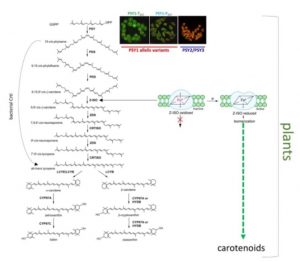 Plants produce hundreds of carotenoids with functions ranging from photoprotection to signalling, and with important roles in human health as well. Wurtzel describes opportunities arising from applying the tools of synthetic biology to carotenoids. The regulation of carotenoid biosynthesis is complex, and one key challenge is to identify switches to modulate the flow of intermediates through one or another branch of the biosynthetic pathway. Another challenge is that many carotenoid biosynthetic enzymes are membrane-localized, hence difficult to crystalize for structural determination. She also points to the opportunities provided by our increasing understanding of apocarotenoids (products of carotenoid cleavage, such as ABA and strigolactones), many of which have important signalling roles. (Summary by Mary Williams) Plant Physiol. 10.1104/pp.18.01122
Plants produce hundreds of carotenoids with functions ranging from photoprotection to signalling, and with important roles in human health as well. Wurtzel describes opportunities arising from applying the tools of synthetic biology to carotenoids. The regulation of carotenoid biosynthesis is complex, and one key challenge is to identify switches to modulate the flow of intermediates through one or another branch of the biosynthetic pathway. Another challenge is that many carotenoid biosynthetic enzymes are membrane-localized, hence difficult to crystalize for structural determination. She also points to the opportunities provided by our increasing understanding of apocarotenoids (products of carotenoid cleavage, such as ABA and strigolactones), many of which have important signalling roles. (Summary by Mary Williams) Plant Physiol. 10.1104/pp.18.01122
Review: Transposable elements play an important role in aluminum resistance
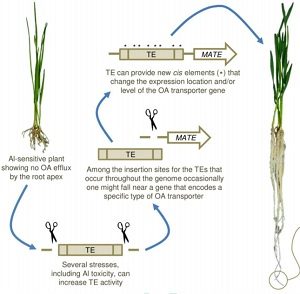 Phytotoxic aluminum can drastically harm plant roots, leading to decreased nutrient uptake, water absorption and yields. Many plant species efflux organic anions into the rhizosphere to reduce the toxic effects of aluminum. Some of the genes that encode transporter proteins which mediate organic anion release contain transposable elements in the coding sequences or in flanking regions. There are transposable element-induced mutations that modify the level or location of transporter-encoded gene expression, resulting in changes in organic anion efflux. This review by Pereira and Ryan covers the role of transposable elements in enhancing the adaptation of plants to aluminum stress. Transposable elements seem to be an important source of mutations that have co-opted organic anion transporter proteins with other functions to perform aluminum resistance-related roles. (Summary by Julia Miller) J. Exp. Bot. 10.1093/jxb/ery357
Phytotoxic aluminum can drastically harm plant roots, leading to decreased nutrient uptake, water absorption and yields. Many plant species efflux organic anions into the rhizosphere to reduce the toxic effects of aluminum. Some of the genes that encode transporter proteins which mediate organic anion release contain transposable elements in the coding sequences or in flanking regions. There are transposable element-induced mutations that modify the level or location of transporter-encoded gene expression, resulting in changes in organic anion efflux. This review by Pereira and Ryan covers the role of transposable elements in enhancing the adaptation of plants to aluminum stress. Transposable elements seem to be an important source of mutations that have co-opted organic anion transporter proteins with other functions to perform aluminum resistance-related roles. (Summary by Julia Miller) J. Exp. Bot. 10.1093/jxb/ery357
Desiccation tolerance evolved through gene duplication and network rewiring in Lindernia
 Desiccation tolerance is the property of being able to survive and recover from extreme dehydration. Although there are many desiccation-tolerant plant species, efforts to identify the genetic basis of desiccation tolerance have been limited by a lack of closely-related desiccation sensitive species. VanBuren et al. compared two species of Lindernia, one of which is desiccation sensitive. The comparison of these closely aligned genomes reveals that some desiccation-tolerance genes such as those encodling LEAs (late-embryo abundant) and ELIPs (early light induced proteins) are substantially duplicated in L. brevidens, and there is a general rewiring of the transcriptional networks. The authors conclude, “Desiccation tolerance likely evolved from a complex, additive series of gene duplications and pathway rewiring rather than a simple master regulatory switch.” (Summary by Mary Williams) Plant Cell 10.1105/tpc.18.00517
Desiccation tolerance is the property of being able to survive and recover from extreme dehydration. Although there are many desiccation-tolerant plant species, efforts to identify the genetic basis of desiccation tolerance have been limited by a lack of closely-related desiccation sensitive species. VanBuren et al. compared two species of Lindernia, one of which is desiccation sensitive. The comparison of these closely aligned genomes reveals that some desiccation-tolerance genes such as those encodling LEAs (late-embryo abundant) and ELIPs (early light induced proteins) are substantially duplicated in L. brevidens, and there is a general rewiring of the transcriptional networks. The authors conclude, “Desiccation tolerance likely evolved from a complex, additive series of gene duplications and pathway rewiring rather than a simple master regulatory switch.” (Summary by Mary Williams) Plant Cell 10.1105/tpc.18.00517
The imprinted gene PEG2 acts as a sponge for the transposon-derived siRNA854, inducing postzygotic reproductive isolation
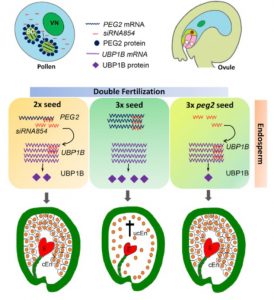 Closely related species that have different numbers of chromosomes (e.g., 2n versus 4n) are reproductively isolated, and this can arise as a consequence of an unbalancing in the expression levels of maternally- and paternally-imprinted genes. Wang et al. have identified a fascinating mechanism that explains why the seeds of different-ploidy hybrids frequently abort. The authors found that PEG2 (Paternally Expressed Gene 2) transcripts act as small RNA sponges for siRNA854, which is present in the vegetative cell of the pollen due to epigenetic reprogramming. One of the natural targets of siRNA854 is UBP1b, which encodes an RNA-binding protein that sequesters transcripts in stress granules. In triploid seeds (formed from diploid / tetraploid hybridization), excess production of PEG2 transcripts sponges up all of the siRNA854, leading to excess production of UBP1b and seed abortion. Thus, a sensitive gene-dosage check that contributes to the “triploid block” has been identified. (Summary by Mary Williams) Dev. Cell 10.1016/j.devcel.2018.07.014
Closely related species that have different numbers of chromosomes (e.g., 2n versus 4n) are reproductively isolated, and this can arise as a consequence of an unbalancing in the expression levels of maternally- and paternally-imprinted genes. Wang et al. have identified a fascinating mechanism that explains why the seeds of different-ploidy hybrids frequently abort. The authors found that PEG2 (Paternally Expressed Gene 2) transcripts act as small RNA sponges for siRNA854, which is present in the vegetative cell of the pollen due to epigenetic reprogramming. One of the natural targets of siRNA854 is UBP1b, which encodes an RNA-binding protein that sequesters transcripts in stress granules. In triploid seeds (formed from diploid / tetraploid hybridization), excess production of PEG2 transcripts sponges up all of the siRNA854, leading to excess production of UBP1b and seed abortion. Thus, a sensitive gene-dosage check that contributes to the “triploid block” has been identified. (Summary by Mary Williams) Dev. Cell 10.1016/j.devcel.2018.07.014
β-cyclocitral is a conserved root growth regulator
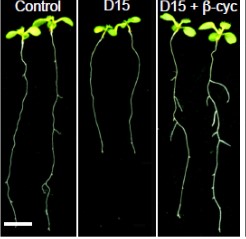 Enhancing root growth can aid plant survival in challenging environments such as salty soils. Dickinson et al. built upon a previous study that identified D15, an inhibitor of lateral root development. They treated roots with D15 and also components of a small-molecule library to search for suppressors of the suppressor: plants with restored root growth. They identified β-cyclocitral, a metabolite of β-carotene. Using several reporter lines, the authors found that β-cyclocitral enhances pre-emergence growth of lateral root primordia by stimulating meristematic cell divisions. The root-enhancing effects of β-cyclocitral also occurr in the absence of D15, and in rice as well as Arabidopsis, even in the presence of salt stress. These results indicate that β-cyclocitral could have applications in enhancing crop growth in adverse conditions. (Summary by Mary Williams) bioRxiv 10.1101/337162
Enhancing root growth can aid plant survival in challenging environments such as salty soils. Dickinson et al. built upon a previous study that identified D15, an inhibitor of lateral root development. They treated roots with D15 and also components of a small-molecule library to search for suppressors of the suppressor: plants with restored root growth. They identified β-cyclocitral, a metabolite of β-carotene. Using several reporter lines, the authors found that β-cyclocitral enhances pre-emergence growth of lateral root primordia by stimulating meristematic cell divisions. The root-enhancing effects of β-cyclocitral also occurr in the absence of D15, and in rice as well as Arabidopsis, even in the presence of salt stress. These results indicate that β-cyclocitral could have applications in enhancing crop growth in adverse conditions. (Summary by Mary Williams) bioRxiv 10.1101/337162
Transcriptional regulation of the immune receptor FLS2 controls the ontogeny of plant innate immunity
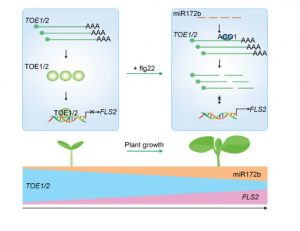 FLS2 is a well-known cell-surface receptor that triggers plant immune response. Zou et al. asked whether its expression level is age-dependent, and found that FLS2 is expressed at very low levels in newly-emerged seedlings. They identified two closely related transcription factors TOE1 and TOE2 that negatively regulate FLS2 expression and FLS2-mediated immunity in very young seedlings. Previous studies identified TOE1/2 as targets of miR172. The authors showed that as plants age, increasing levels of miR172 gradually suppress the inhibitory effects of TOE1/2, enabling FLS2 expression. Interestingly, flg22 (which mimics pathogen proteins) also increases miR172 levels, promoting expression of FLS2. The authors note that this, along with miR172’s well-known role in promoting flowering, could coordinate plant growth, immunity and flowering time. (Summary by Mary Williams) Plant Cell 10.1105/tpc.18.00297
FLS2 is a well-known cell-surface receptor that triggers plant immune response. Zou et al. asked whether its expression level is age-dependent, and found that FLS2 is expressed at very low levels in newly-emerged seedlings. They identified two closely related transcription factors TOE1 and TOE2 that negatively regulate FLS2 expression and FLS2-mediated immunity in very young seedlings. Previous studies identified TOE1/2 as targets of miR172. The authors showed that as plants age, increasing levels of miR172 gradually suppress the inhibitory effects of TOE1/2, enabling FLS2 expression. Interestingly, flg22 (which mimics pathogen proteins) also increases miR172 levels, promoting expression of FLS2. The authors note that this, along with miR172’s well-known role in promoting flowering, could coordinate plant growth, immunity and flowering time. (Summary by Mary Williams) Plant Cell 10.1105/tpc.18.00297
JAZ repressors of metabolic defense promote growth and reproductive fitness in Arabidopsis
 Jasmonates promote defense reponses but at the expense of growth. JAZ proteins repress jasmonate responses. Guo et al. examined the consequences of knocking out 10 of the 13 JAZ genes in Arabidopsis, by producing a jaz decuple, or jazD mutant. They compared jazD mutant to previously described jazQ mutants that have five JAZ genes knocked out, and found that jazD is more severe in all responses than jazQ. As expected, jazD mutant show enhanced defense and severely reduced growth responses. The authors analyzed transcriptomic and proteomic data and found that jazD mutants exhibit symptoms of carbon starvation, even though rates of photosynthesis are comparable to wild-type plants. They suggest that this apparent carbon-starvation is because the plants use large amounts of energy in their production of defense compounds. The authors conclude: “We propose that JAZ proteins assist in balancing the growth–defense continuum not as a binary on–off switch but rather by matching the biotic stress level to available resources“. (Summary by Mary Williams) Proc. Natl. Acad. Sci. USA
Jasmonates promote defense reponses but at the expense of growth. JAZ proteins repress jasmonate responses. Guo et al. examined the consequences of knocking out 10 of the 13 JAZ genes in Arabidopsis, by producing a jaz decuple, or jazD mutant. They compared jazD mutant to previously described jazQ mutants that have five JAZ genes knocked out, and found that jazD is more severe in all responses than jazQ. As expected, jazD mutant show enhanced defense and severely reduced growth responses. The authors analyzed transcriptomic and proteomic data and found that jazD mutants exhibit symptoms of carbon starvation, even though rates of photosynthesis are comparable to wild-type plants. They suggest that this apparent carbon-starvation is because the plants use large amounts of energy in their production of defense compounds. The authors conclude: “We propose that JAZ proteins assist in balancing the growth–defense continuum not as a binary on–off switch but rather by matching the biotic stress level to available resources“. (Summary by Mary Williams) Proc. Natl. Acad. Sci. USA


